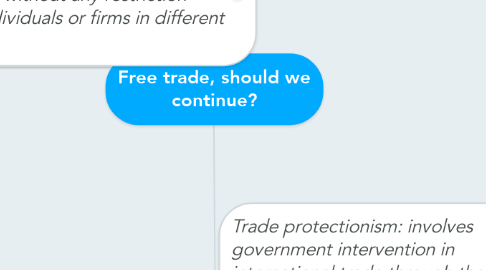
1. Free trade: absence of government intervention of any kind in international trade. Trade without any restriction between individuals or firms in different countries
1.1. Advantages
1.1.1. can lead to a more efficient allocation of resources through specialization.
1.1.1.1. comparative advanages
1.1.1.2. absolute advantages
1.1.2. Improves international relationship between countries
1.1.3. Consumers can buy products in lower price than the price after tariff is imposed
1.1.4. More choices for consumers
1.1.5. Increased efficiency due to the competition
1.1.6. Flow of the idea and technology
1.1.7. Acquiring needed resources
2. Trade protectionism: involves government intervention in international trade through the imposition of trade restrictions (barriers) to prevent the free entry of imports into a country or to protect the domestic economy from foreign competition.
2.1. Types of protectionism
2.1.1. Purpose
2.1.1.1. To protect the domestic industry from foreign goods
2.1.2. Tariff
2.1.2.1. Definition: Tax imposed on foreign goods
2.1.2.2. Overall Effect
2.1.2.2.1. Increase in domestic quantity supplied,
2.1.2.2.2. Increase the government revenue
2.1.2.2.3. decrease in domestic quantity demanded
2.1.2.2.4. decrease in domestic imports
2.1.2.3. Who benefits?
2.1.2.3.1. Domestic producers
2.1.2.3.2. Domestic employemnts
2.1.2.3.3. Government by gaining tax revenue
2.1.2.4. Worse off?
2.1.2.4.1. Domestic consumers
2.1.2.4.2. Foreign producers
2.1.2.4.3. Income distribution because tariff is a type of regressvie tax
2.1.2.4.4. increase inefficiency in production
2.1.3. Import Quota
2.1.3.1. Definition: Legal limit to the quantity of goods that can be imported in typical period
2.1.3.2. Overall Effect
2.1.3.2.1. Increase in domestic production
2.1.3.2.2. Decrease in foreign imports
2.1.3.2.3. Decrease in quantity demanded
2.1.3.3. Who benefits?
2.1.3.3.1. Domestic producer better off
2.1.3.3.2. Domestic employment rate
2.1.3.4. Worse off?
2.1.3.4.1. Increased inefficiency in production
2.1.3.4.2. Domestic consumers
2.1.4. Subsidies
2.1.4.1. Definition: Government providing financial support to the firm
2.1.4.2. Overall effect
2.1.4.2.1. Increase in domestic supply
2.1.4.2.2. Decrease in imports
2.1.4.2.3. Consumption isn't affected
2.1.4.3. Who benefits?
2.1.4.3.1. Domestic producers
2.1.4.3.2. Domestic emplpyments increase
2.1.4.4. Worse off?
2.1.4.4.1. Taxpayers are worse off
2.1.4.4.2. The exporting countries are worse off
2.1.4.4.3. Increased inefficiency of production
2.1.4.4.4. Negative effect on government budget

